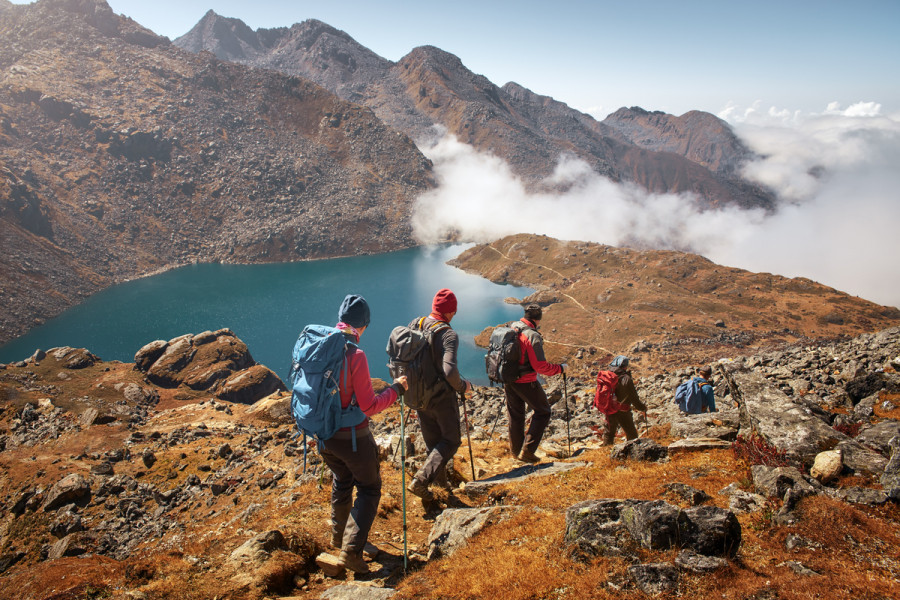Columns
Keeping track of tourists
To make tourism a driver of the Nepali economy, we must first collect accurate industry-related data.
Hikmat Singh Ayer
The Nepali tourism industry hit hard by the pandemic is gradually recovering, with a 68 percent increase in international tourists in 2021 compared to 2019. According to the Department of Immigration, 614,148 foreign tourists arrived in Nepal by air in the past year. The year 2019 recorded the highest number of foreign tourist arrivals, with 895,884 coming in by air and 201,307 by land. The lowest number of foreign tourist arrivals was recorded in 2021, with 150,625 arriving by air and 337 by land. In the past year, 34 percent of all tourists, or 209,105, were Indians who came by air. The Ministry of Culture, Tourism and Civil Aviation is working to determine the number of Indian tourists who arrived by land using entry permits for four-wheeled buses, jeeps, and cars who stayed in Nepal for more than one day. Indians returning on the same day do not count as tourists.
It is essential to accurately track the number of tourists entering the country by air and land to understand the impact of the tourism industry on local businesses and the national economy. If the engagement of tourists with each business is accurately recorded, we can determine the actual contribution of the tourism industry to the national gross domestic product (GDP). However, statistics from the Nepal Government show that the tourism industry only contributed 2 percent to the GDP in 2018-2019, while the World Travel and Tourism Council estimates a contribution of 7.5 percent for the same period. This discrepancy suggests problems with our method of collecting and calculating tourism statistics.
There is no comprehensive record of the number of foreign or domestic tourists visiting major tourist cities like Kathmandu and Pokhara. The Tourist Information Management System (TIMS) keeps records of foreign nationals visiting trekking areas like Annapurna and Everest. There is some record-keeping of all international visitors at the Lumbini Mayadevi temple area, mountaineering expeditions, national parks, and conservation areas. Such statistics are insufficient to fully understand the tourism industry. In the absence of complete statistics, current estimates of the industry's contribution to the economy are based on the transactions and tax payments of tourism businesses and foreign exchange earnings. The current system for tracking tourism data in Nepal relies on estimations that may not accurately reflect the reality of the industry. The Hotel Professional Federation of Nepal estimates that there are 80,000 members in the industry, including hotels, restaurants, party venues, banquets, coffee shops, bakeries, tea shops, lounge bars and resorts. However, actual data is often elusive.
In addition to arriving by air, tourists enter Nepal from the southern border with India and the northern border with China. There are 17 entry points connected to India, and transportation and traffic police manually track the movement of vehicles entering and exiting the country. Many Indian tourists take a one-day pass to visit Nepal temporarily, purchasing goods and using hotels, restaurants and casinos before returning in the evening. These tourists are not counted as tourists because they do not stay overnight. There is also no record of pedestrians or people who come and go by rickshaw. After the Bihar government banned the sale and distribution of alcohol in 2016, the arrival of Indian tourists in Nepal, particularly in the entertainment industry, has increased significantly. Indian tourists also visit water parks and casinos in Nepali border towns and nearby hill stations like Ilam, Bhedetar, Daman, Palpa, and Pokhara on the weekends with their families.
Recently, large hotels, restaurants, casinos, and water parks have been opening in the developing cities of Nepal's terai region and experiencing good business, as shown by the transaction and tax records of the businesses. The opening of five-and four-star hotels in cities like Mechinagar in Jhapa, Bhairahawa, and Nepalganj, and the plans to open similar hotels in Biratnagar, Janakpur, Bhairahawa-Butwal, and Dhangadhi, demonstrate the promising business prospects in the border cities of Nepal. However, due to the lack of proper record-keeping for tourists arriving by land, the government has failed to provide amenities such as parking, toilets, and food and drink options for these tourists.
The Tourism Satellite Accounting (TSA) system is a tool developed by the United Nations World Tourism Organization (UNWTO) to help governments measure the economic and social impact of tourism on a national level. It allows the collection and analysis of data on various aspects of the tourism industry, including employment, investments, and foreign exchange earnings. By implementing the TSA system, the government of Nepal could better understand the tourism industry's contribution to the country's gross domestic product (GDP) and use this information to plan and develop the sector. It is crucial to complete the project as soon as possible so that the government can start using the TSA system to make informed decisions about the tourism industry in Nepal.
To improve record-keeping for tourists arriving by land, the government could consider implementing a system for collecting and analysing data from hotels, guest houses, resorts, and transportation companies at border entry points and major tourist destinations. This data could be used to publish regular reports on the number of tourists visiting Nepal and their activities. Examples abound in other countries, such as the entry system at Rampo in Sikkim, India, and the visa-free entry system for Indian citizens in Bhutan. The government could consider implementing this system at major entry points and tourist destinations such as Ilam, Dharan, the Kathmandu Valley, Nagadhunga, Pokhara, Chitwan, Manang, and Mustang.
The Tourism Department estimates that 5,233 rooms will be added to 35 five-star hotels within a year and a half. Creating a mechanism to collect the necessary data related to the tourism sector is necessary. With the correct information, we can improve the tourism sector as a whole, the import and export of our economy, discounts and conveniences in the economic transactions of various businesses, and determine the tax rate. This will also help in securing the investment of banks, preventing criminal activities and human trafficking at our border cities and various destinations, and ensuring good security and smooth traffic management on the highways and major destinations. This will increase the attractiveness and quality of service in tourist destinations, provide a good experience for tourists and give them a lifetime memory of Nepal.




 11.12°C Kathmandu
11.12°C Kathmandu















